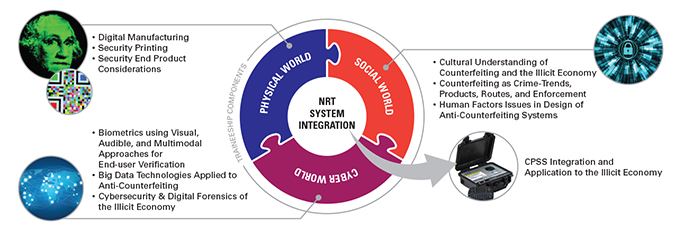Researchers at South Dakota School of Mines
& Technology are helping uncover and stop underground criminal networks
that illegally traffic in everything from electronics and drugs to organs and
weapons. These illegal activities are a multibillion dollar drain on the U.S.
economy and a threat to global and personal security. Two separate grants from
the National Science Foundation (NSF) to Mines’ Center for Security Printing and
Anti-Counterfeiting Technology (SPACT) help forward crime fighting efforts.
Building the Next
Generation of Science-Based Crimefighters
The
modern problem of counterfeiting is far beyond printing fake money.
Counterfeiters are selling a huge range of goods from sneakers to fire alarms to
medicine; and many consumers are unable to tell the difference between faulty,
and sometimes dangerous, counterfeit products and the authentic versions. The
counterfeiting epidemic is now a $1.5 trillion global enterprise. Counterfeiting
is a serious safety and national security concern, and this illegal activity negatively
impacts nearly every economic sector.
The
National Science Foundation has
awarded a $3 million grant to a new project called the Cyber-Physical-Social
System for Understanding and Thwarting the Illicit Economy. Jon Kellar, Ph.D., SPACT
Director and a professor of Materials and Metallurgical Engineering at SD Mines,
is leading a team of researchers that includes Grant Crawford, South Dakota
School of Mines & Technology; Ashley Podhradsky, Dakota State University;
Brian Logue, South Dakota State University; and Stanley May, University of South Dakota.
The
project is part of the NSF Research Traineeship (NRT) program that is “designed
to encourage the development and implementation of bold, new, and potentially
transformative models for STEM graduate education training. The NRT program
seeks proposals that explore ways for graduate students in research-based
master’s and doctoral degree programs to develop the skills, knowledge, and
competencies needed to pursue a range of STEM careers.”
The
project includes a comprehensive approach that combines three collaborative
research areas. One part of the project deals in the physical world, including
the effort to identify counterfeit items, such as pharmaceuticals, and work on
anti-counterfeiting efforts such as the use of nanoparticle-based inks in
unique markings to identify authentic goods. A second branch of study focuses
on the cyber world and it includes internet-based investigations such as
digital forensics and an effort to better understand the cyber/physical
interface. The third part of the project is the social world and in building a
cultural understanding of the counterfeiting and illicit economy this includes,
understanding crime trends and the human factor in the design of
anti-counterfeiting systems.

“This
traineeship program is the first of its kind in the country aimed at producing
the next-generation of science-based leaders in the fight against
counterfeiting and disrupting the illicit economy,” says Kellar.
This
NSF award is one of 17
projects in total that include $51 million in funding tied to the NRT program.
Thwarting
Counterfeiting with Cutting Edge Technology
A
second grant
from the (NSF) totals $300,000 and helps scientists identify how
illegal networks operate. The Early-concept Grant for Exploratory Research
(EAGER) includes both South
Dakota School of Mines & Technology and Colorado State
University to help target and take down illegal networks.
“Our
role will primarily be printing of security features on goods that might be targeted
by counterfeiters,” says Kellar
This
research at Mines is one of nine NSF-funded awards aimed at disrupting these
illicit supply networks. An NSF press release
states, “The new awards support research that combines engineering with
computer, physical and social sciences to address a danger that poses
significant consequences for national and international security. Nimble and
technologically sophisticated networks traffic in contraband that includes
people, illegal weapons, drugs, looted antiquities and exotic animal products.
Unencumbered by national boundaries, they funnel illicit profits to criminal
organizations, and fuel transnational and terrorist organizations.”